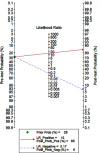Accuracy of Non-Contrast MRI for the Detection of Hepatocellular Carcinoma: A systematic review and meta-analysis
- PMID: 35480538
- PMCID: PMC9002405
- DOI: 10.12669/pjms.38.3.5142
Accuracy of Non-Contrast MRI for the Detection of Hepatocellular Carcinoma: A systematic review and meta-analysis
Abstract
Non-contrast MRI is used for identifying patients with hepatocellular carcinoma (HCC), especially among high-risk patients with cirrhosis or chronic viral hepatitis. The accuracy of non-contrast MRI has been investigated with varying results. We performed this meta-analysis to consolidate the evidence on the accuracy of non-contrast MRI for the detection of HCC. We conducted a systematic search in the databases of PubMed Central, SCOPUS, MEDLINE, EMBASE and Cochrane from inception till November 2020. We used the STATA software "Midas" package for meta-analysis. We included 15 studies with 3,756 patients. The pooled sensitivity and specificity of non-contrast MRI for HCC detection were 84% (95%CI, 78%-88%) and 94% (95%CI, 91%-97%). The positive likelihood ratio was 14.9 (95% CI, 9.0-24.7) and the negative one 0.17 (0.12-0.23). The overall quality of the studies was high. We found significant heterogeneity based on chi-square test results and I2 statistic > 75%. Deek's test showed the absence of publication bias. We found that non-contrast MRI has high sensitivity and specificity as a tool for detecting HCC. Studies exploring its accuracy in different ethnic populations are required to strengthen the evidence.
Keywords: Hepatocellular Carcinoma; Magnetic Resonance Imaging; Meta-analysis; Validation studies.
Copyright: © Pakistan Journal of Medical Sciences.
Figures
Similar articles
-
Accuracy of Various Forms of Contrast-Enhanced MRI for Diagnosing Hepatocellular Carcinoma: A Systematic Review and Meta-Analysis.Front Oncol. 2021 Dec 7;11:680691. doi: 10.3389/fonc.2021.680691. eCollection 2021. Front Oncol. 2021. PMID: 34950573 Free PMC article.
-
Diagnostic accuracy of fine-needle aspiration cytology for lymphoma: A systematic review and meta-analysis.Diagn Cytopathol. 2021 Sep;49(9):975-986. doi: 10.1002/dc.24800. Epub 2021 May 18. Diagn Cytopathol. 2021. PMID: 34004059
-
Computed tomography vs liver stiffness measurement and magnetic resonance imaging in evaluating esophageal varices in cirrhotic patients: A systematic review and meta-analysis.World J Gastroenterol. 2020 May 14;26(18):2247-2267. doi: 10.3748/wjg.v26.i18.2247. World J Gastroenterol. 2020. PMID: 32476790 Free PMC article.
-
Utility of the DECAF score for predicting survival of patients with COPD: a meta-analysis of diagnostic accuracy studies.Eur Rev Med Pharmacol Sci. 2021 Jun;25(11):4037-4050. doi: 10.26355/eurrev_202106_26045. Eur Rev Med Pharmacol Sci. 2021. PMID: 34156682
-
Diagnostic accuracy of cardiopulmonary ultrasound for pulmonary embolism: A systematic review and meta-analysis.Echocardiography. 2022 Feb;39(2):185-193. doi: 10.1111/echo.15280. Epub 2022 Jan 13. Echocardiography. 2022. PMID: 35026045
Cited by
-
Efficiency of indocyanine green fluorescence assisted laparoscopic hepatectomy in patients with hepatocellular carcinoma.Pak J Med Sci. 2025 Jan;41(1):119-124. doi: 10.12669/pjms.41.1.10626. Pak J Med Sci. 2025. PMID: 39867755 Free PMC article.
-
Geriatric nutritional risk index as a predictor of prognosis in hepatocellular carcinoma: A systematic review and meta-analysis.Pak J Med Sci. 2025 Apr;41(4):1244-1252. doi: 10.12669/pjms.41.4.11962. Pak J Med Sci. 2025. PMID: 40290253 Free PMC article. Review.
References
-
- Meissner HI, Smith RA, Rimer BK, Wilson KM, Rakowski W, Vernon SW, et al. Promoting cancer screening:Learning from experience. Cancer. 2004;101(5 Suppl):1107–1117. doi:10.1002/cncr.20507. - PubMed
Publication types
LinkOut - more resources
Full Text Sources




